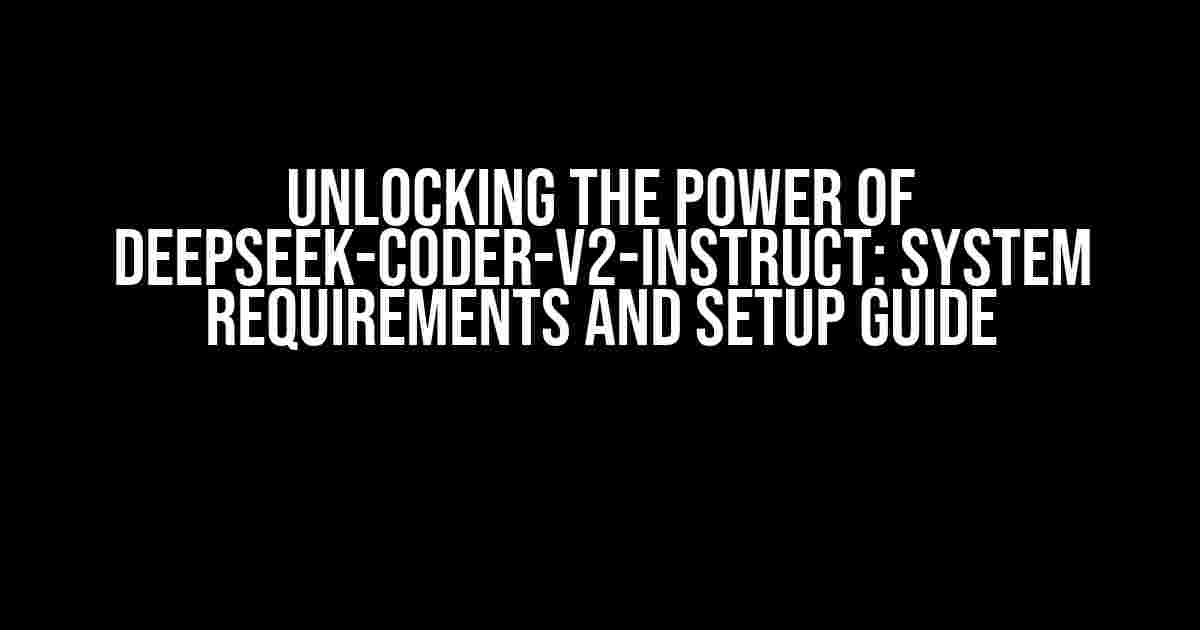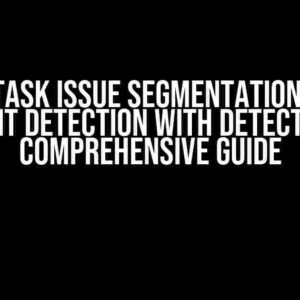Welcome to the world of AI-powered coding, where the impossible becomes possible! In this comprehensive guide, we’ll delve into the system requirements for the DeepSeek-Coder-V2-Instruct, a revolutionary tool that’s changing the landscape of code development. Get ready to unlock its full potential and take your coding skills to new heights!
System Requirements: The Essentials
Before we dive into the setup process, let’s ensure your system meets the minimum requirements to run the DeepSeek-Coder-V2-Instruct smoothly. Please check the following:
Operating System:64-bit Windows 10 or later, or macOS High Sierra or laterProcessor:Intel Core i5 or AMD equivalent (at least 2.5 GHz)Memory:16 GB RAM (32 GB or more recommended)Storage:256 GB free disk space (SSD recommended)Graphics:NVIDIA GeForce GTX 1060 or AMD equivalent (at least 4 GB VRAM)Internet Connection:Stable internet connection (at least 10 Mbps)
Software Requirements: The Must-Haves
In addition to the system requirements, you’ll need to ensure you have the following software installed:
Python 3.8 or later:The DeepSeek-Coder-V2-Instruct uses Python as its primary programming language. You can download the latest version from the official Python website.TensorFlow 2.x or later:This popular open-source machine learning library is essential for the DeepSeek-Coder-V2-Instruct’s AI capabilities. Install it via pip:pip install tensorflowpip 20.0 or later:The package installer for Python, pip, is required to install and manage dependencies. Ensure you’re running the latest version.
Setup and Installation: A Step-by-Step Guide
Now that you’ve met the system and software requirements, let’s proceed with the setup and installation process:
1. Download the DeepSeek-Coder-V2-Instruct installer from the official website. 2. Run the installer and follow the on-screen instructions to install the software. 3. Once the installation is complete, launch the DeepSeek-Coder-V2-Instruct application. 4. You'll be prompted to create a new project or open an existing one. Choose "New Project" to create a new codebase. 5. Select the project type (e.g., web development, machine learning, etc.) and choose the desired template. 6. Specify the project name, location, and other details as required. 7. Click "Create Project" to initialize the project. 8. The DeepSeek-Coder-V2-Instruct will now prompt you to install the required dependencies and libraries. Follow the on-screen instructions to complete the process.
Configuring the DeepSeek-Coder-V2-Instruct: Advanced Settings
For advanced users, the DeepSeek-Coder-V2-Instruct offers a range of customizable settings to fine-tune its performance. Access these settings by navigating to:
File > Settings > Advanced
| Setting | Description |
|---|---|
| Model Complexity | Adjust the complexity of the AI model to optimize performance and accuracy. |
| GPU Acceleration | Enable or disable GPU acceleration to take advantage of your system’s graphics processing power. |
| Memory Allocation | Configure the memory allocation strategy to optimize performance for large codebases. |
Troubleshooting Common Issues
Encountered an issue during setup or usage? Don’t worry, we’ve got you covered! Here are some common issues and their solutions:
Error: "TensorFlow not found": Ensure TensorFlow is installed and properly configured. Try reinstalling TensorFlow or checking the installation logs.Error: "Insufficient memory": Increase the memory allocation or consider upgrading your system’s RAM.Error: "GPU acceleration not available": Verify that your system meets the minimum GPU requirements or disable GPU acceleration in the settings.
Conclusion: Unlocking the Full Potential of DeepSeek-Coder-V2-Instruct
With the DeepSeek-Coder-V2-Instruct up and running, you’re ready to unlock its full potential! This powerful tool is designed to revolutionize the way you code, and with the right system requirements and setup, you’ll be able to take advantage of its advanced AI capabilities. Remember to stay tuned for updates and new features, and don’t hesitate to reach out to our support team if you encounter any issues.
Happy coding, and welcome to the future of development!
Here are 5 Questions and Answers about “System Requirements for the DeepSeek-Coder-V2-Instruct” in a creative voice and tone, using HTML:
Frequently Asked Questions
Get ready to dive into the world of DeepSeek-Coder-V2-Instruct! Before you begin, make sure you’ve got the right gear to tackle this amazing tool. Check out these FAQs to ensure you’re fully equipped for the journey ahead!
What kind of operating system do I need to run DeepSeek-Coder-V2-Instruct?
You’ll need a 64-bit operating system, either Windows 10 or macOS High Sierra (or later) to run DeepSeek-Coder-V2-Instruct smoothly. Sorry, Linux fans, but Windows and macOS are the only supported platforms for now!
How much RAM do I need to have to run DeepSeek-Coder-V2-Instruct?
To avoid any hiccups, we recommend having at least 16 GB of RAM. But if you want to run multiple instances or large projects, aim for 32 GB or more. Trust us, your computer (and your sanity) will thank you!
What kind of GPU do I need to run DeepSeek-Coder-V2-Instruct?
You’ll need a dedicated NVIDIA GPU with at least 4 GB of VRAM to run DeepSeek-Coder-V2-Instruct. The recommended GPU is an NVIDIA Quadro RTX 4000 or higher. If you’re using an integrated GPU, sorry to say, but it won’t cut it.
Do I need an internet connection to use DeepSeek-Coder-V2-Instruct?
Yes, an active internet connection is required to access DeepSeek-Coder-V2-Instruct’s cloud-based services and receive updates. But don’t worry, we won’t hog your bandwidth – a stable connection with a minimum speed of 1 Mbps will do just fine!
Can I run DeepSeek-Coder-V2-Instruct on a virtual machine?
Sorry to say, but running DeepSeek-Coder-V2-Instruct on a virtual machine (VM) isn’t supported at the moment. We recommend installing it on a physical machine to ensure optimal performance and stability.
I hope you find these FAQs helpful!



